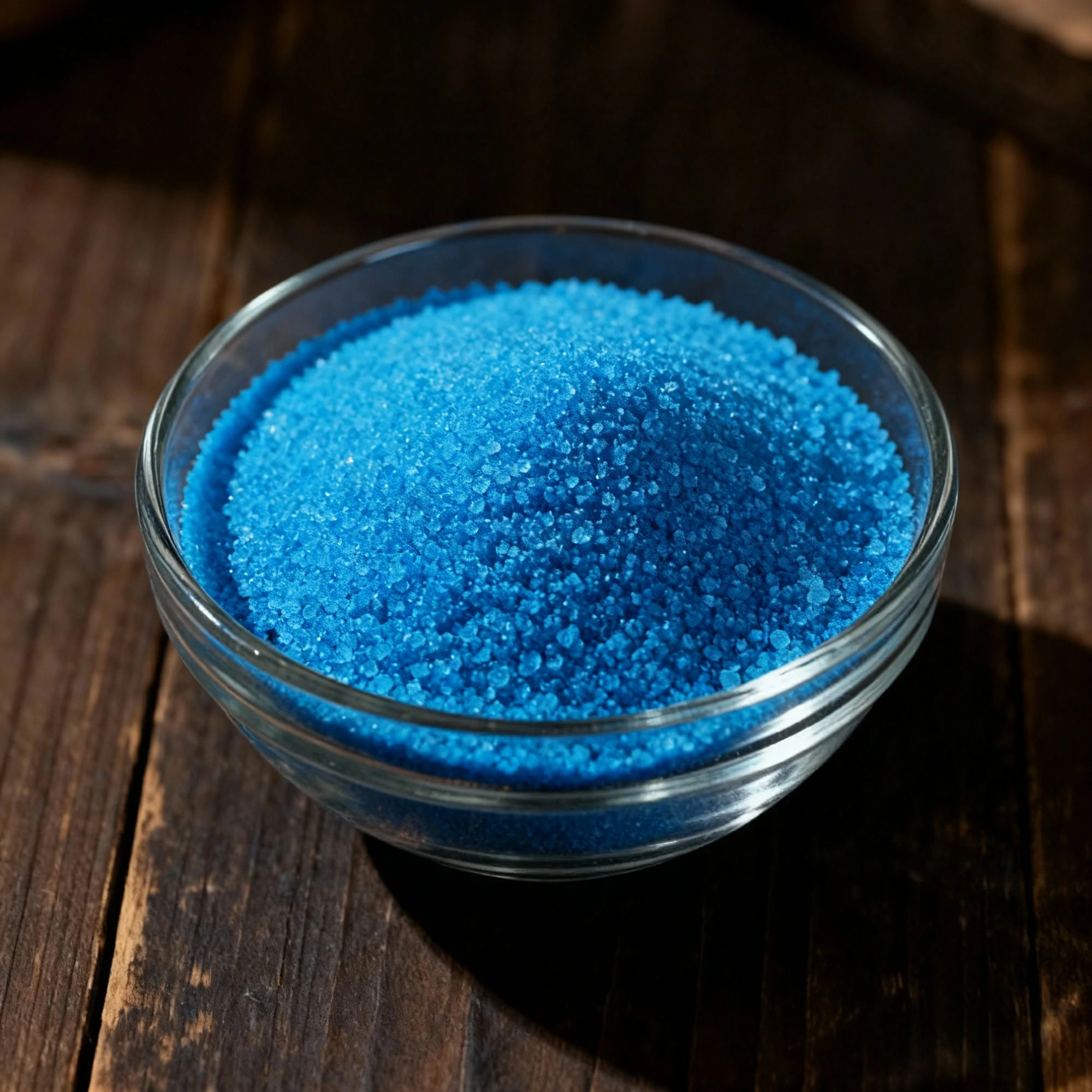

Copper Glycinate
One unit of:Unknown
Product Info
What is Copper Glycinate?
Copper Glycinate is a highly bioavailable mineral supplement where the essential trace mineral copper is chelated with the amino acid glycine, primarily used to provide necessary copper nutrition in foods, animal feeds, and dietary supplements.
How is Copper Glycinate made?
| Step No. | Production Stage | Key Action | Control Point & Note |
|---|---|---|---|
| 1 | Chelation Reaction | React a soluble copper source (e.g., copper sulfate) with glycine in an aqueous medium. | Raw Material Purity: Both copper salt and glycine must meet pre-defined quality specifications. Molar Ratio: The ratio of copper to glycine is critical for reaction efficiency and product quality. A 1:2 molar ratio is typical. pH & Temperature: The pH is adjusted (typically to slightly alkaline) and temperature is controlled to optimize the chelation process. |
| 2 | Purification & Filtration | Filter the reaction slurry to remove any unreacted solids or insoluble impurities. | Filtrate Clarity: The resulting solution must be a clear, deep blue color, free of suspended solids. Filter Integrity: Check filter cloths/media for damage to prevent contamination of the pure solution. |
| 3 | Crystallization & Separation | Concentrate the solution via evaporation to induce crystallization, then centrifuge the slurry to separate the solid crystals from the mother liquor. | Concentration Level: Monitor specific gravity or solids content to determine the optimal point for crystallization. Centrifuge Efficiency: Optimize speed and duration to achieve a low-moisture "wet cake" and maximize product yield. |
| 4 | Drying | Dry the wet copper glycinate crystals in a controlled dryer (e.g., vacuum, fluid bed) to remove residual moisture. | Drying Temperature: Must be kept relatively low to prevent thermal decomposition or oxidation, which can alter the product's color and chemical structure. Final Moisture Content: Drying must continue until a specific moisture level (e.g., <1%) is reached to ensure stability and prevent caking. |
| 5 | Milling & Sieving | Mill the dried product to achieve the desired particle size, then sieve to ensure uniformity and remove oversized particles. | Particle Size Distribution (PSD): Use a specific mesh size to meet product specifications. This is crucial for solubility and blending properties. Foreign Matter Control: Ensure equipment is clean and sieves are intact to prevent contamination. |
| 6 | Homogenization & Packaging | Blend the final sieved powder for batch homogeneity and package into sealed, moisture-proof containers. | Batch Uniformity: Adequate blending time is essential to ensure every sample from the batch is consistent in composition. Package Integrity: Use packaging (e.g., foil-lined bags) that protects the product from moisture and light. Weight & Labeling: Calibrated scales for accurate net weight and correct labeling with batch number are mandatory for traceability. |
Technical Specifications
| CAS Number | 13479-54-4 |
| Chemical Formula | C₄H₈CuN₂O₄ |
| Solubility | 0.52 g per 100 g water at 25 °C (slightly soluble) |
| Storage Conditions | Cool, dry, dark place |
| Shelf Life | 24 Months |
Applications & Usage
Common Applications:
Mechanism of action:
| Parameter | Copper Glycinate |
|---|---|
| Functional Category | Bioavailable Mineral Source; Nutritional Additive; Chelated Trace Mineral. |
| Key Ingredients | Copper (II) ion; Glycine (amino acid). |
| Mechanism of Action | Chelates the copper ion with two molecules of the amino acid glycine. This neutral, stable complex protects the mineral from antagonistic interactions and precipitation in the digestive tract. It is absorbed intact via amino acid transport pathways in the small intestine, resulting in significantly higher bioavailability compared to inorganic copper salts (e.g., copper sulfate). |
| Application Effect in Product | Enhanced copper absorption and retention in target species (livestock, poultry, aquaculture); improved enzyme function (e.g., lysyl oxidase for connective tissue); supports immune system health, hemoglobin synthesis, and growth rates; reduces mineral excretion and environmental impact. |
Comparison:
| Product Name | Category/Type | Key Features | Strengths (vs peers) | Weaknesses (vs peers) | Best Use Cases | Why Choose |
|---|---|---|---|---|---|---|
| Copper Glycinate | Chelated Mineral | Copper bonded to the amino acid glycine. | Superior bioavailability and absorption; exceptionally gentle on the digestive system. | Higher cost than non-chelated forms like sulfate or gluconate. | Long-term supplementation, individuals with sensitive stomachs or compromised absorption. | For maximum, gentle absorption with minimal risk of gastrointestinal upset. |
| Copper Gluconate | Organic Salt Mineral | Copper salt of gluconic acid. | Good bioavailability (better than inorganic salts); widely available and affordable. | Less bioavailable than true chelates like glycinate or picolinate; can cause stomach upset in sensitive users. | General daily supplementation for non-sensitive individuals; cost-effective choice. | A balanced, affordable option with decent absorption for general use. |
| Copper Sulfate | Inorganic Salt Mineral | Inorganic salt of copper. | Extremely inexpensive. | Poor bioavailability; high potential for causing nausea and gastrointestinal irritation; competes with other minerals. | Rarely recommended for human supplementation; found in some low-cost multivitamins. | Not a recommended choice for supplementation due to low absorption and side effects. |
| Copper Citrate | Chelated Mineral | Copper bonded to citric acid. | High bioavailability, similar to other chelated forms; generally well-tolerated by the digestive system. | Can be more expensive than gluconate. | Effective copper supplementation, good for correcting deficiencies. | A highly bioavailable option when glycinate is unavailable or for user preference. |
| Copper Picolinate | Chelated Mineral | Copper bonded to picolinic acid. | Considered to have one of the highest absorption rates among all forms. | Often the most expensive form of supplemental copper. | When rapid correction of a deficiency is required or for maximum possible uptake. | For the highest possible absorption rate, backed by strong research on picolinate chelates. |
Technical Documents
Available Documentation
Technical dossier available
Safety Data Sheet (SDS)
Available
Certificate of Analysis (COA)
Quality assurance documentation
Technical Data Sheet
Detailed technical specifications